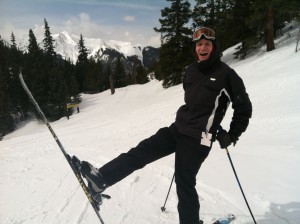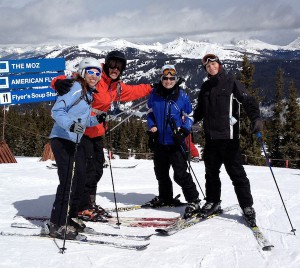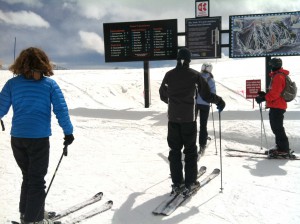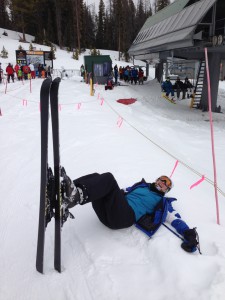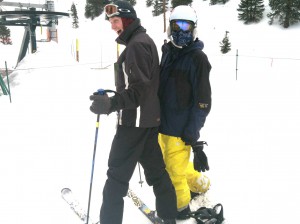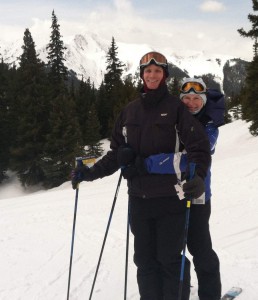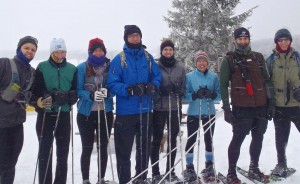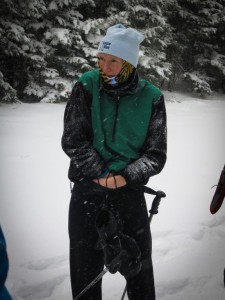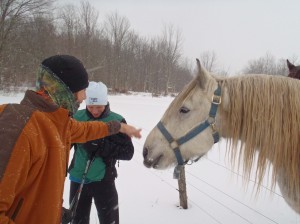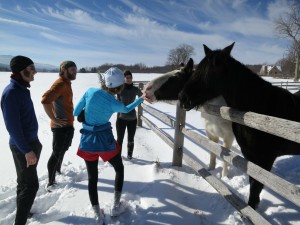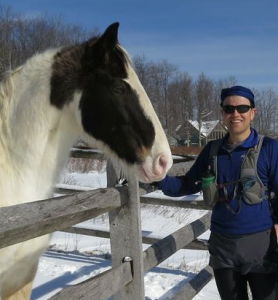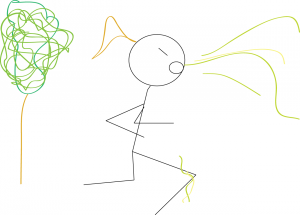Once again, the Frisco Ultra Contingent regrouped for its traditional April ski trip to Colorado, although this time with some notable changes. In a major departure from the norm, Sean A. now has his own condo in Frisco and spent the majority of the vacation tapping into his inner Martha Stewart, picking out new home decor with him mom, Sue Ellen, who flew from Ohio to Frisco for a weekend of (a) helping Sean select floor boards, (b) getting ditched by Sean on trail runs, and (c) getting ditched while Sean went out skiing with his friends. In all fairness, the fact that Sean skipped out on so much beautiful sunny skiing that we don’t even have a picture of him is true testament to his new-found dedication to home fancying.
Aaron and Linda W. are FUCing regulars. How did I get on the Kerry/Doug invite list? My boyfriend comes with Benefits.
We were supposed to be training for our Snow-Boot-Race-Of-Champions (SBROC), but fortunately Doug reclaimed our Safeway shopping cart at the bus depot to perpetuate a time-honored FUCing tradition.
I think the highlight of the trip for Kerry was Saturday night when she thought that her weird neighbor was at her door and it instead turned out to be Billy (‘Billybob’) L. After filling our evening with stories (we’re still not sure what went down with those Australian tourists in Bangkok….), Billy then joined us for a couple days as our token snowboarder, greatly contributing to our FUCing fashion — and giving a good name to snowboarders (who have not been in our good graces since knocking down Aaron’s mom and fracturing her pelvis in January).
I have to say, I am completely sold on April skiing. Sure, the snow could be a bit mushy in places, but I’d trade that for sun and blue skies in a heart beat, and on Sunday we even got fresh snow fall. Sign me up to be a FUCing regular.
For the many devoted followers of the Snow Pony reports, you get to end the season with a bang (yes, I’m leaving for Italy Wednesday and won’t be back until March 9th, so no more visits to the snow ponies til next year). Yesterday in Canaan, a ferocious snow pony mistook the tip of Aaron’s xc ski for a carrot, and the next thing we knew it was Man Down. I apologize for not having any camera footage. Seeing the pony take the tip of Aaron’s ski in its mouth and send him flailing backwards was one of the funniest things I’ve seen in a while.
[Inspired by conversations with Art, Joe, and the rest of the WUSsies at CPBG]
In the model of Eats Shoots and Leaves, we intentionally have left the title of Eat Shit & Run ambiguous in order to apply to a wider range of WUSsies: (a) the majority of whom simply eat, shit, and run, as well as (b) the singularly spectacular Sean Andrish, who actually eats shit and runs, very fast and very far. Undoubtedly, Sean also must shit, but Eat Shit Shit & Run seemed a bit wordy and lost our double entendre.
Entering his mid-forties amid a burgeoning pool of elite ultra competitors has not been gentle on our dear Sean’s ego. His tongue has not taken kindly to the taste of the dust kicked back at him by the young upstarts, who recently have been spilling over from road running into the ultra scene in droves. But, as I have explained to Sean on many a Wednesday night run, Legend Never Dies. He could slip way back to the middle of the pack, and everyone would still fawn on Sean the Great. Images stick, in the same way that parents continue to treat you as if you were still eight, even when you are CEO of a major conglomerate, have two children of your own, and are perfectly capable of finding the mustard in the fridge. (In the case of Sean, some moms do not believe their adult sons can purchase their own sticks of deodorant.)
Sean Andrish: Legend Never Dies could have been a perfectly apt title for this book. We hope no one interprets our selection of Eat Shit & Run as any kind of slap at Scott Jurek, or the virtues of quinoa that are extolled in his Eat and Run manifesto. None of us would disagree with the premise that all humans would surely benefit from healthier diets that include less processed food. But we aim to make a simple point: the belief that following Scott Jurek’s culinary advice will make you fast because it made Scott speedy is no less preposterous than advising runners to adopt fellow speedster Sean’s diet, which seems to consist of no actual nutrients. If vegan eating was as essential to human endurance running as Jurek has posited, one must conclude either that (a) Sean could become the world’s fastest ultra runner if only we could substitute quinoa cakes for his breakfast of Mt Dew and poptarts, or, intriguingly, (b) Sean is not in fact human.
Although tempting to imagine what kind of space alien kidneys might reside within Sean, our strong inclination is to go with Option 3: the Individualized Diet. Perhaps the likelihood of omega 3’s enhancing Sean’s performance may be no greater than Mt Dew’s new faux-healthful breakfast drink Kickstart giving Jurek’s mojo a boost. We are not suggesting that Sean’s aberrational athletic performance on a zero nutritional value diet debunks the large body of scientific evidence that suggests a diet of Mt Dew and hotpockets is not good for America. Rather, our argument is a bit subtler: athletes, as with humans in general, can thrive off of extremely variable diets, with Sean representing his own, rather unique, end of the spectrum. We doubt that the Sean diet is a good fit for more than 0.01% of the population. But we also doubt that an extreme vegan diet is the ideal fit for most runners, particularly female athletes.
Unfortunately, a health book with the message This diet MIGHT work for you is not nearly as compelling or marketable as a book that purports to improve the health of all, resulting in the proliferation of books that advocate a narrowly defined diet for a large number of people (ie, anyone willing to buy the book). Although good for profit margins, such an approach goes against the Genomic Age of science that we have been rapidly entering since the sequencing of the entire human DNA genome in 2000. Some day sequencing an individual’s entire DNA genome will be standard practice, and treatments and medications will be personalized to fit an individual genomic make-up. Humans vary considerably in physiology, and a major current problem in treating human disease is that conditions such as diabetes and cancer are highly heterogeneous, meaning that even patients with similar outward symptoms can respond very differently to various treatments and regimens. To oversimplify, the current approach to treating complex multifactorial symptoms such as type II diabetes can be likened to a mechanic who sees a ‘check engine’ light in your car. Rather than diagnosing the specific problem, he simply goes down a list of possible part failures (engine, transmission, tires…) trial by error until the car starts working again. Not a very time- or cost-efficient way of getting your car back on the road. In an age of individualized genomic medicine, doctors will be able to pinpoint the precise problem that is giving rise to high blood sugar, for example, and treat with targeted therapies, rather than blindly trying different meds until something works.
Although there have been some groundbreaking successes in individualized medicine, such as the treatment of children’s cancer, where the high cost of sequencing the entire human genome is surely justified, the costs are still too high for this practice to become standard. But we don’t have to know our precise genetic makeup in order to apply the principles of individualized medicine to more sensibly approach our diet. Just as a one-size-fits-all model of medical practice is rapidly becoming debunked, a one-size-fits-all model of diet is clearly an unuseful oversimplification.
Following fads is a natural part of being an American. (I was going to use a reference to lemmings, but I recently found out that the story of herds of cliff-diving lemmings is entirely myth. For reasons not entirely understood, lemming populations are prone to sharp fluctuations. During times of extremely high growth, large numbers will migrate to less-populated areas, a journey fraught with the perils of exposure to predators and dangerous river crossings. The sight of lemmings drowning in high numbers perhaps gave rise to the popular perception of mass suicide).
It is unlikely that anyone, even the charismatic Sean Andrish, is capable of breaking the deeply ingrained (pun intended) American food fad obsession, which would seemingly require some twisty double lightsaber that could subdue the media with one end and human evolution with the other. But if there is anyone who can be a poster boy for The Great Dietary Reality Check, it is Sean. Sean, who can win a 100-mile race with nearly 30,000 ft of elevation change, having subsisted on a diet of Mt Dew, poptarts, hotpockets, McDonald’s, and epilepsy medications. (Yes, these feats are all the more impressive given that Sean has a variant of epilepsy that is extremely poorly controlled, despite brain surgeries and chip implants, and a continually carouseling regimen of pill that sometimes make it impossible for him to lift his feet. Every time I hear on the radio that someone was hit by a metro train I have to wonder if Sean had another seizure by the tracks again.)
Readers will likely come away from this book split into two camps. One group will feel vindicated, thinking You know, I always thought those diet books were a loada crap as they bite into their bacon cheeseburger. On the other hand, those looking for dietary rules and guidelines, like that adorable USDA pyramid with the cartoon drumsticks and bread loaves, will probably feel left hanging. For the folks in the former group, we knew you weren’t going to change your diets anyway, so we hope you at least find this book entertaining. For those in the latter group, we can’t provide a panacea, but we hope this book still provides some insights into the range of diets that can still be healthful for running, the potential risks of following extreme dietary fads that are beneficial to only a small percentage of people, and a general framework for how to go about determining whether a diet is a particularly good fit for you or not (which basically boils down to: When I eat that do I feel like crap?. Health books can be useful for providing ideas and personal success stories to consider and possibly experiment with, especially for those trying to overcome fatigue or stomach ailments. But at the end of the day you have to find what works for you. When I started dating a vegetarian, my meat intake naturally plummeted. But so did my energy during runs. It turns out my boyfriend can win races munching his veggies, but some girls clearly need their t-bones. We’re not at the point where genomic testing can reveal why my boyfriend and I have such distinct physiological differences, but frankly it doesn’t matter. Eat what works for you, and let others eat what works for them. And whatever happens, keep running.
WUS Weekend at the Chophouse
January 26-27, 2013
The Tuesday before the planned WUSsie escape to Canaan the slopes were grass. But on Friday and Saturday the valley delivered. Snowshoeing for all!

Another version of the ‘Aaron Special’: a seven-mile snowshoe loop around Whitegrass [photo courtesy of K Knipling]
On Sunday the skies cleared and we were treated to a beautiful, sunny snow run.
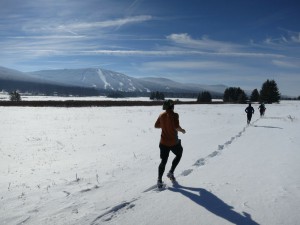
Adam happy to be running sans sled (Timerline ski area in the background) [photo courtesy of K Knipling]
Willis River Trail Race 35k/50k
Saturday, January 12, 2013
Bear Lake Park, VA
The Willis River Trail Race (formerly known as the Swinging Bridge 50k) was supposed to be a nice little confidence booster leading up to my much-anticipated crusade to redeem myself this year at Holiday Lake, after losing the lead last year in a fit of vomiting at the last aid station in what I consider the most demoralizing race finish of my life — even worse than the time I collapsed on Boylston Street in the last stretch of the Boston Marathon in 2009 (where I was able to get up and stagger across in 2:55 for 42nd place female).
Although I was able to cling on the win in the 35k at Willis River, and felt fluid and strong for most of it, the Barfies returned with a vengeance, representing a marked set-back in my long-running quest to become an ultra-runner (pun intended). Overall it a great warm day and a fun winding course through Bear Lake Park, situated about an hour west of Richmond. As Sean had warned me, everyone continually went off-trail and half the challenge was just staying on the darn course. Just as I started to put a good gap on second place I would go off-course and end up behind her again — it happened at least three times.
But after 17-18 or so miles of pure cruising at Willis River, feeling completely in control of the race despite the off-course detours, it all started again. It begins innocuously enough, with a soft gag on whatever I’m trying to eat. A mile or so later it develops into a dry heave, where my stomach contracts hard and I just vomit a little into my mouth. The next time I heave it all spills out of my mouth (I’d like to be able to claim it was a pretty projectile vomit like the one in the picture here, but really most of it just dribbled down my face, chest, and onto my knees).
The only difference between here and Holiday Lake was that there was a 35k option, so I knew that if I just toughed it out a couple more miles I could stop running and forget the last 10 miles of the 50k. With a fiery determination to finish without giving up the lead I dug in and run through the dry heaves and at least 3 full-fledged vomits.
The trail went on interminably, twisting and winding, and at one point I seriously considered just curling up in a little ball on the side of the trail and taking a little break from the great unpleasantness for a while. But I knew that Holly Bugin (winner of the UROC 50k, 4th at MMTR) was still on my heels (in part because I kept getting lost) and it wasn’t long to the finish.
As I approached the finish I started to vomit again, but slowed my pace down to hold it in. But when I crossed the line I just let it all out in front of an audience of spectators and other finishers. Some of their reactions were classic. Our friend from Canaan, Luke, was there, and he gave me some water after I crumpled into a pile of wet leaves. Aaron trotted in a little later and happy to screw the 50k, call it a day at 35k and go home. I got some warm stuff on and was able to chat with some of the folks at the finish — Sophie and Mike Bailey (who’d twisted his ankle and dropped) and Caroline Williams (who’d gotten so lost she had to drop too), as well as Matt and Holly Bugin, whom I’d run part of the race with. But ultimately I had to get my sick self home.
Where do I go from here? I have deep reservations about revisiting what was such an awful experience last year at Holiday Lake, especially when I clearly have made no progress on fixing my stomach. I’m really dejected because I love to trail race, and I’d love to move up into longer distances, even try a 50-miler. I’ve got the half marathon trail run distance down pat, with a 4-for-4 undefeated win streak for half marathon trail races (3x WHM + 1 Dam Half), and I feel like there’s a lot potential in my legs to go the distance. But I’m not going to slog through misery each time I run long.
I might try some different nutrition products. I was recommended Hammer gels and Generation UCAN. At first I thought Aaron’s suggestion that I skip the 50k and just jump to 50mi sounded crazy. But maybe a longer, less intense cruise would be easier on the gut? Heck, at this point I’m willing to try anything.
Archives
- ► 2024 (6)
- ► 2023 (3)
- ► 2022 (3)
- ► 2021 (9)
- ► 2019 (13)
- ► 2018 (7)
- ► 2017 (16)
- ► 2016 (27)
- ► 2015 (27)
- ► 2014 (29)
- ► 2013 (26)
- ► 2012 (42)
- ► December (9)
- 2013: another year, another chance to try to not f&*k everything up
- A White Canaan Christmas
- A very merry fat ass
- The Long-Awaited Weinberger WUS
- Survey Response
- Team Floo Fighters Jingle All the Way
- Neil Young versus the Silver Diner juke box
- Um, ignore last posting - guy is CREEPY
- Looking for Lost Love on Shady Grove Road
- ► November (3)
- ► October (6)
- ► September (7)
- ► August (1)
- ► July (3)
- ► June (5)
- ► April (4)
- ► March (2)
- ► February (2)
- ► December (9)
- ► 2011 (69)
- ► December (2)
- ► November (5)
- ► October (4)
- ► September (5)
- ► August (7)
- ► July (4)
- ► June (7)
- ► May (15)
- Luna's Beer Mile
- Happy birthday, Mario!
- Kerry's Death March - May 21, 2011
- A moment in time. The first WUS run.
- Kerry's Death March
- Choose Your Own Adventure
- The Bear
- Come hither. Drinketh from the WUS cup.
- Neal's take
- When did it happen?
- When will it happen?
- NIH Take a Hike Day
- If it ain't on video, it didn't happen
- The REALLY big question
- Beer Mile: Post-Race Coverage
- ► April (16)
- Layers
- Thoughts of a beer-miler
- Beer Mile Haiku
- Beer Mile: Post-Race Coverage Preview In Which Sean B Expresses The Consensus Emotion On The Topic Of Beer Miles
- Beer Mile
- Beer Mile: Pre-Race Coverage
- Beer Mile Logistics
- Sean Thumb
- Donut Run
- Frisco Ultra Contingent
- Logistical Information for Inaugural WUS Donut/Beer Run Series
- WUS shirt
- Charlottesville Marathon
- Bull Run: A 50 Mile Sonnet
- Trail Maintenance in Rock Creek Park
- ► March (4)
Recent Comments
- Kerry Owens on Hellgate 100km++ 2024
- Seb on WUS Awards 2024
- Jaret on WUS Awards 2024
- Kirstin on Richmond Marathon: Not Dead Yet
- Mario on Richmond Marathon: Not Dead Yet
